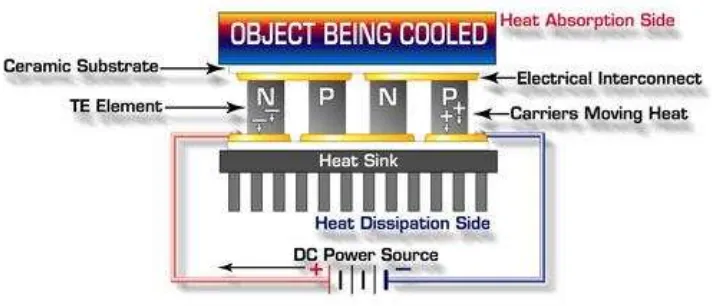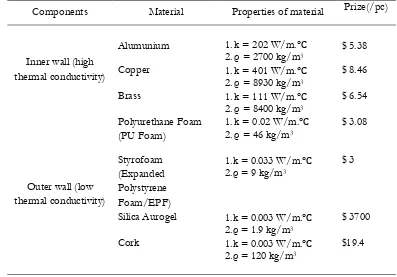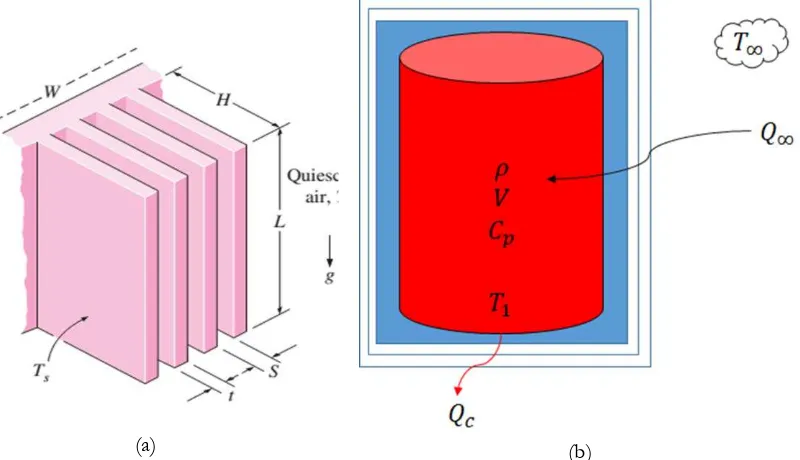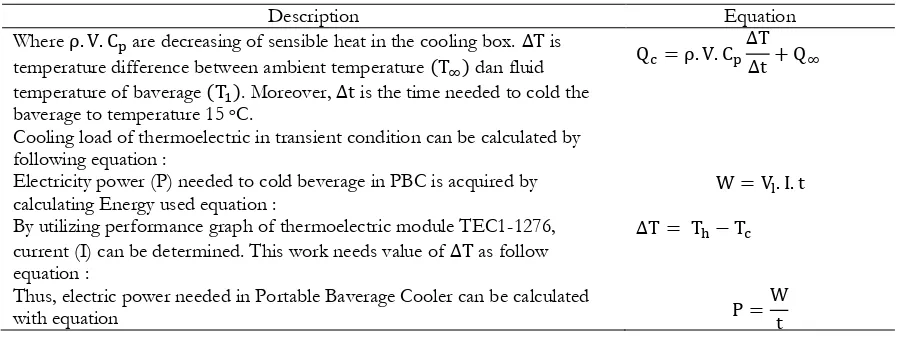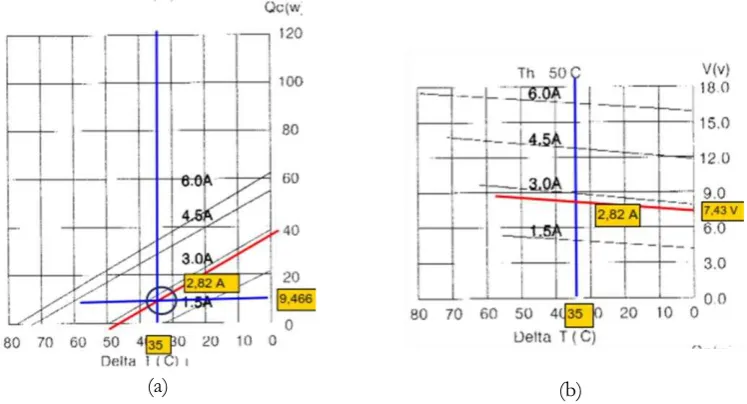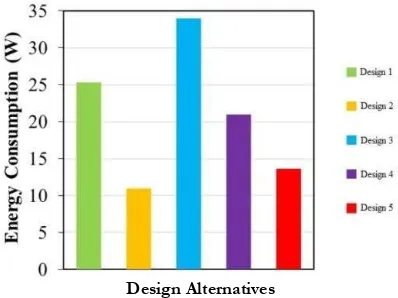29
Aceh International Journal of Science and Technology
ISSN: 2088-9860 eISSN: 2503-2348
Journal homepage: http://jurnal.unsyiah.ac.id/aijst
Design of Portable Beverage Cooler Using One Stage
Thermoelectric Cooler (TEC) Module
Azridjal Aziz 1*, Rahmat Iman Mainil1, Afdhal Kurniawan Mainil2, Syafri1,
Muhammad Faizal Syukrillah1
1Department of Mechanical Engineering, Universitas Riau, Pekanbaru, Indonesia 2Department of Mechanical Engineering, University of Bengkulu, Bengkulu, Indonesia
*Corresponding author email: [email protected]
Received : November 3, 2016 Accepted : February 17, 2017 Online : April 27, 2017
Abstract –The Portable Beverage Cooler (PBC) has been designed to satisfy the need of cooler apparatus that could be carried easily. The utilization of this apparatus was intended to minimize the environmental damage affected by vapour compression refrigeration system using CFCs Refrigerant. The peltier effect from thermoelectric module was utilized in this PBC and called as Thermoelectric Cooler (TEC). Furthermore, heat-sink and fan were needed to ensure the cooling effect continously worked. To achieved the objectives of this machine (portable, environment-friendly, low watt, affordable), the design consideration are heat load, insulating material, weight of components, electric consumption, and dimension of the cooling box. The results of the design shows the PBC cooling box dimension is 6 cm x 6.5 x 15 cm. The insulation of the PBC cooling box are polyurethane foam and polystyrene expanded with thickness 6 mm and 5.3 mm, respectively. The alumunium plate was applied as inner wall to enhance the cooling capacity of cooling room temperature. In this PBC was used one stage of TEC that could yield cooling room temperature until 15 oC in 30 minutes operation by consuming 20 W of electricity.
Keyword: Cooler, peltier effect, thermoelectric module, cooling box, cooling capacity .
Introduction
The vapour compression refrigeration machine used CFC (Cloro Fluro Carbon) refrigerant as working fluids are generally used nowadays. It has several drawbacks for the environtment such as Ozone Depletion Potential (ODP) and Global Warming Potential (GWP). Many studies proved that the refrigerant contributed around 15%-12% of global warming which lead to increasing of earth temperature. As the result, the damage of ozone and increasing of global warming will lead to degradation of global ecosystem. Despite some bad impacts as mentioned before, this machine generally has huge dimension that will encounter difficulties if people intend to carry it.
To find out the alternative of cooling apparatus, people tend to use systems which not only environtmentally friendly but also easy to be carried and used. Therefore, the apparatus should be able to works as a cooler or heat pump but it does not work with vapour compression refrigeration machine like refrigerator. TEC module is aimed to overcome this problems (Salah et al., 2009, Abdul-Wahab et al., 2009, and Mainil et al., 2015). As a mini refrigeration machine, PBC utilized TEC module as cooling media has advantages such as easy to carry, compact shape, no vibration, environment-friendly, and low energy consumption (Riffat and Ma, 2003).
30
the heat from a cooling room. The cooling process of peltier effect is shown in Figure 1 (www.ferotec.com, 2016).
Development of thermoelectric for household refrigeration has been conducted by Min and Rowe, 2006. An experimental study indicated that Coefficient of Performance (COP) of thermoelectric range from 0.3-0.5. From that study, the potention of enhancing performance by improving the thermal contact in thermoelectric modul and heat exchanger can be undertaken (Min and Rowe, 2006). Riyanto and Yoewono, 2010, developed a portable cooling apparatus in 2007. The apparatus cold the beverages with power consumption 23 Watt. Salah et al., 2009 utilize solar radiation as energy source to generate the cooling effect on thermoelectric cooler. This cooling apparatus was developed for remote area that difficult to get electricity
Figure 1. Schematic Process of Peltier Effect (https://thermal.ferrotec.com/technology/, 2016)
Zhao and Tan, 2014 conducted the research on the potential use of TEC modules, the basic material of TEC, modeling and application for small-scale cooling needs]. Mainil et al., 2015 studied about application of thermoelectric module in a modified of water dispenser. They research indicated that the cooling box temperature reach 14 oC in 36 minutes. In this study, the design of Portable Beverages
Cooler was carried out from five design alternative. The target of cooling room temperature was 15 oC in
30 minutes operation by 20 Watt of power source
Materials and Methods
To perform the design of PBC, the design requirements were needed to acquire PBC in accordance to the objectives of cooling apparatus. The requirements were:
1. The shape of PBC is simple like rectangular box.
2. The dimension ofCooling boxcompatibel to the baverage cans.
3. Cooling box insulator has high thermal conductivity with light mass to guarantee the total weight of PBC less than 2 kg.
4. The apparatus can reach 15 oC temperature of cooling box in 30 minutes.
5. Low watt (less than 20 W) 6. Affordable
7. The apparatus is save and user friendly
Design of material
31
There are several material could be used for inner and outer wall of PBC that is shown in Table 1.
Table 1 shows several materials that can be used to manufacture cooling box of PBC. The mentioned
parameters are thermal conductivity (k), density (ρ) and the unit price. Judging from the ability of thermal conductivity, copper is the best materials for the inner wall, but they are expensive and heavy (it has the
greatest value of ρ). Aluminum is the second best material for inner wall with low price and lightweight
(smallest value of ρ). Therefore, it will appropriate to select aluminum as the material for the inner wall of
a portable beverage cooler.
Silica aurogel is the best material used for insulating based on Table 1 (Riyanto and Yoewono, 2010). Despite the low thermal conductivity of this material it also has light mass. However, this material is expensive. Due to cost consideration the selection of insulating material was decided to combine two material which have low thermal conductivity as well as cheap and be able to withstand the cooling box load. Thus, due to properties, price, and manufacturing process, polyurethane foam and expanded polystyrene foam were proper combination as insulating material.
Table 1. Material of inner and outer wall (insulation) (Riyanto and Yoewono, 2010)
Components Material Properties of material Prize(/pc)
Inner wall (high
The dimension and design of PBC consider the measurement of baverage cans (250 ml, 330 ml, 600 ml) shown in Table 2 and Figure 2a. The mechanism of heat transfer from outside to inside of PBC walls is described by Figure 2b.
Table 2. Indicating five alternatives of PBC dimensions
32
Figure 1. Portable Baverages Cooler Design (a) and Heat Load Through the Walls (b)
Calculation of heat transfer rate in PBC design
Calculation of heat transfer of PBC design alternatives use Microsoft Excell worksheet. The equation used for PBC design shown in Table 3a and Table 3b. Moreover, the calculation focuses on heat transfer rate from outside to inside cooling room, insulation thickness, and number of TEC to satisfy the requirements and objectives that had been mentioned before.
To get coefficient of convection on heatsink is acquired from surface value (W x L). Where W is lenght while L is height of heat sink as shown in Figure 3 a. In addition, at transient condition, TEC absorb heat from cans, room, walls, and heat gain from surroundings in difference to time, as shown by Figure 3b.
Figure 3. Heatsink (Cengel and Boles, 2011) (a) and Heat Transfer in Transient Condition (b)
(a) (b)
33
Table 3a.Equation for PBC design (heat transfer equation)
Description Equation
Heat capacity transferred from outside to inside of cooling box can
be calculated as follows the equation : Q∞= U x A x ∆T Where ∆T is temperature difference between environtment
temperature T∞ and room temperature of cooling box T . U is overall heat transfer coefficient that can be calculated as follows equation:
UA =
h A +k A +L k A +L k A + h AL
k , k and k are thermal conductivity of walls for wall 1, wall 2, and wall 3 respectively. Coefficient of natural convection is calculated using equation :
h
=L [ .k + . RaL
[ + . /Pr ] Pr]
Value ofQ is heat transfer from environtment temperature to outer wall of PBC, whereas Q is heat transfer from inner wall of PBC to cooling room. Heat transfer rate of Q dan Q is calculated as follows equation :
Q = h. A ∆T
Heat transfer coefficient of convectionhcan be calculated by define the Rayleigh Number(RaL) and Nusselt Number (Nu). The
Rayleigh Number(RaL) can be acquired from the equation : RaL=
β Ts−T∞L Pr
In convection heat transfer on vertical wall, Nusselt Number is
acquired by using following equation : Nu
= [ . + . RaL
[ + . /Pr ] Pr]
Meanwhile, for calculating Nusselt number in horizontal wall, this
equation is appropriate : Nu = . . RaL After Rayleigh Number(RaL) and Nusselt Number (Nu) have been
figured out, thusheat transfer coefficient of convection (h) can be undertakenas follows the equation :
h =L Nuk
Morover, to get optimum distance of sink S , equation can be
used as follows: S = .
L RaL. Convection coefficient of the heatsink (h) is determined from
nusselt number. Nusselt number will constant when distance of heatsink (S) = optimum distance of heatsink S about 1.307. Therefore, to calculate coefficient of convection of heatsink can use equation :
h =Nu kS
To calculate heat transfer of heatsink can use equation in the right box, where k is thermal conductivity of air in film temperature, n is number of sink, H is lenght of sink from the base, and ∆T
temperature difference between ambient temperature T∞ and heatsink temperature T :
Q a = h nLH ∆T
Table 3b.Equation for PBC design (transient equation and power equation)
Description Equation
Where ρ. V. C are decreasing of sensible heat in the cooling box. ∆T is temperature difference between ambient temperature T∞ dan fluid temperature of baverage T . Moreover, ∆t is the time needed to cold the baverage to temperature 15 oC.
Cooling load of thermoelectric in transient condition can be calculated by following equation :
Q = ρ. V. C ∆T∆t + Q∞
Electricity power (P) needed to cold beverage in PBC is acquired by
calculating Energy used equation : W = V . I. t By utilizing performance graph of thermoelectric module TEC1-1276,
current (I) can be determined. This work needs value of ∆T as follow equation :
∆T = T − T
Thus, electric power needed in Portable Baverage Cooler can be calculated
with equation P =
34
Hot side temperature of thermoelectric module (T is collected from spesification data of thermoelectric module TEC1-12706, which is 50 oC. Cold temperature of cooling side of thermoelectric
module T 19 ℃. Afterwards, by using calculation result of Q in y axis, current (I) can be figured out as can be seen in Figure 4a. By using ∆T on x axis and current (I) on y axis the voltage of thermoelectric module V can be figured out. This process is shown by Figure 4b.
Figure 4. Determining The Current (a) and Determining Voltage (b) (www.habei.com.cn, 2016)
Results and Discussion
Selection of PBC design alternatives is initially by analyzing heat load through PBC walls, weight of components, and power consumption for cooling process. These resullts are used to select the optimum design among five alternatives PBC dimension. Table 4 shows different weight of five design alternatives of PBC. The lightest of the design alternatives is design number 2 about 1.143 kg. Although design 2 has the lightest weight, all design alternatives can satisfy design requirement for weight criteria which is no more than 2 kg.
Figure 5 indicates that there are five different alternatives in selecting appropriate dimension of Portable Beverage Cooler (PBC) based on heat load absorbed by thermoelectric cooler. The Figure 5 shows that the design number 3 has the highest heat transfer rate about 0.845 W. Whereas, design 2 has the lowest heat load about 0.746 W. However, design 4 is also have low heat load about 0.01 W over than design 2.
Figure 5.Heat load of Five Design Alternatives Q∞
35
Tabel 4. Weight of PBC in different design alternatives
Design Length (m) Wide (m) High (m) Weight (kg)
1 0.065 0.070 0.12 1.156
2 0.055 0.057 0.14 1.143
3 0.100 0.100 0.23 1.365
4 0.060 0.065 0.15 1.163
5 0.080 0.075 0.17 1.228
The heat should be rejected from beverage cans and then is absorbed by thermoelectric cooler are vary depend on cooling time. The faster cooling time is needed to achieve cooling temperature the more heat load should be rejected in such period of time. The Figure 6 shows that in 20 minutes in design 3 the energy as heat that should be absorbed by thermoelectric is 25.932 W, while the lowest is design 2 with only 11.199 W.
In this study, power consumption as important requirement to ensure the efficiency of PBC. The Figure 7 describes that design no 3 has highest energy consumption about 34 W compare to other alternatives. The smallest energy consumption is utilized by design 2 around 10.197 W. Three other alternatives design 1, design 4 and design 5, have energy consumption 25.145 W, 20 W and 14 W, respectively. Therefore, according to design requirement that allows only 20 W of electric power, design 1 and 3 should be excluded in design selection.
Figure 6. Comparison of Product Heat Load in Transient Condition Q
Design Alternatives
Figure 7. Comparison of Power Needed For Each Alternatives (P) (b)
36
dimension, and weight criteria. However, due to user friendly in using the apparatus, design 2 has weaknesses. That design have small dimension that difficult to put or take cans into it. Therefore, design 4 is considered as the most optimum design due to design requirements and objectives (low heat load, low power consumption, light, able to achieve cooling temperature 15 oC in 30 minutes.
Conclusions
The designing process of Portable Beverage Cooler (PBC) can be concluded that the calculation and design had been carried out based on design the requirements and objections of PBC. Design requirement and objectives is used to deliver an optimum design of PBC. Development of mathematical model to calculate heat transfer rate, weight of apparatus, power consumption is useful to select the appropriate dimension of PBC. Selected PBC design has dimension 6 cm x 6.5 x 15 cm with polyurethane foam and polystyrene expanded as insulator has 6 mm and 5.3 mm thickness, respectively. The power which is needed to achieve cooling room temperature (15 oC) in 30 minutes is 20 W.
Acknowledgement
The authors would like to express their appreciation for financial support from Universitas Riau and Ministry of Research, Technology and Higher Education (PNBP Research Grant 2016).
References
Abdul-Wahab, S. A., Elkamel, A., Al-Damkhi, A. M., Al-Habsi, I., Al-Rubay’ey’, H. S., Albattashi, A. K., Al-Tamimi, A. R., Al-Mamari, K. H. and Chutani, M. U. 2009. Design and experimental
investigation of portable solar thermoelectric refrigerator. International Journal of Renewable Energy, 34(1): 30-34.
Aziz, A., Subroto, J. and Silpana, V. 2015. Aplikasi modul pendingin termoelektrik sebagai media pendingin. Jurnal Rekayasa, 10(1): 32-38.
Cengel, Y. A. and Boles, M. A. (2011). (2011). Thermodynamics an Engineering Approach, Mc. Graw-Hill International Edition 11, pp. 640-641.
Ge, T. S., Dai, Y. J. and Wang, R. Z. 2016. Experimental study on water-cooled thermoelectric cooler for CPU under severe environment. International Journal of Refrigeration, 62: 30–38.
https://thermal.ferrotec.com/technology/ (accessed on April 13th 2016).
Kaushik, S. C., Hans, R. and Manikan S. 2016. Theoretical and experimental investigations on solar photovoltaic driven thermoelectric cooler system for cold storage application. International Journal of Environmental Science and Development, 7(8): 615–625.
Mainil, R. I., Aziz, A. and Mainil, A. K. 2015. Penggunaan modul thermoelectric sebagai elemen pendingin box cooler. Proceeding of Seminar Nasional XIV Rekayasa Dan Aplikasi Teknik Mesin di Industri, 16: 2-7.
Min, G. and Rowe, D. M. 2006. Applied thermoelectric domestic-refrigerators. International Journal of Applied Energy, 83: 133–152.
Riffat, S. B. and Ma, X. 2003. Thermoelectrics: A review of present and potential applications. Journal of Applied Thermal Engineering, 23(8): 913–935.
Riyanto, H. and Yoewono, S. 2010. Kaji penerapan efek peltier untuk alat kecil-ringan. Proceeding of Seminar Nasional Tahunan Teknik Mesin Ke 9 (SNTTM), pp.13–15.
Salah, W., Taib, S. and Al-mofleh, A. 2009. Development of TEC system for commercial cooling applications. International Journal of Modern Applied Science, 3(4): 203-208.
www.habei.com.cn. (accessed on August 1st 2016)
